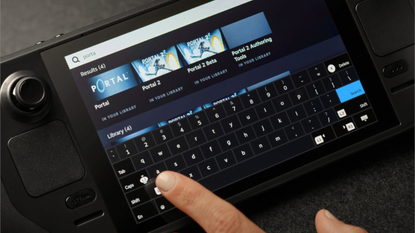Valve just unveiled its surprise new gaming handheld, Steam Deck, and it looks like a very cool idea, giving you all your PC games in a Switch-like portable. Dropping it right as the Switch OLED pre-orders are starting is especially cold on Valve's part, in a way you can only respect.
But looking at the specs that will power it, my first thought was "Is this really the best they can do?" Because I've been covering the Apple M1 chip since its launch close to a year ago, and when you dig into the numbers, it's alarming how much more performance Apple's chip seems to offer compared to the AMD hardware the Steam Deck is packing – particularly since the two chips are made to fit in pretty much exactly the same 15W thermal package, so you really could swap the M1 right into the Steam Deck's hardware (sort of).
Some of it is quite basic – the Steam Deck's processor is four cores (with eight threads) compared to eight actual cores on the Apple M1 (though four are less powerful). But we can actually compare benchmarks to see what kind performance to expect, even though the AMD CPU seems to be custom.
We know it's a Zen 2 chip, with 4 cores and 8 threads, running from 2.4-3.5GHz, and that it's designed to fit in a 15W thermal limit. That's pretty much exactly the spec that the Ryzen 3 5300U uses for its CPU – the 5300U just runs at a slightly faster clock speed. So let's use that as our benchmark for a comparison with the Apple M1.
The highest Geekbench 5 scores for the Ryzen 3 5300U I can find are 1,061 in single core, and 4,043 in multi-core. For the Apple M1 in the MacBook Air (M1, 2020) and ultra-thin iPad Pro 12.9-inch (2021) those scores are 1,737 for single core and 7,468 in multi-core.
That's not a small improvement, that's a total drubbing. That's 70-80% better performance at the same power draw!
Let's get graphical
Looking at the GPU is much more complicated, but let's start with estimates of the raw GPU compute power: Valve says the Steam Deck offers 1.6TFlops (FP32), while Apple says you get up to 2.6TFlops (FP32) from the M1's GPU.
That is, again, more than a 50% improvement on Apple's chip. However, the architecture is important here – Apple's GPU is a beast, but the AMD RDNA 2 system that's being used in Steam Deck has been refined for strong performance per watt in the next-gen consoles, and includes some specific features the M1 doesn't have, including ray tracing hardware acceleration.
AMD could also be including some of its other cache tech that means that the apparent power of the GPU doesn't really tell the story of its performance. But it's still pretty alarming that the number we do know is pretty far behind Apple's equivalent.
The M1 doesn't lead in all areas, though. Both chips are built around unified memory architecture, and offer 16GB of shared RAM, but the Steam Deck will use LPDDR5, while the M1 uses LPDDR4, though it looks likely that both are 128-bit (Valve hasn't confirmed).
Impossible??? Yes, probably
All of this is just fantasy, of course. Apple is never going to licence out the M1 chip for others to use, though I really wish it would for devices that don't really compete with what Apple is making – Steam Deck or the fabled Switch Pro in particular, because it's miles beyond what we're likely to see from AMD, Intel or Nvidia for the next few years. Though Apple might consider those direct competitors with the iPad and Apple Arcade, really.
Even if Apple did have a change of heart, there's the matter of compatibility, of course. The Apple M1 chip is ARM, while the Steam Deck needs to run x86 for compatibility with the entire library of Steam games, so that's an awkward start. Neither the M1 nor the Steam Deck support DirectX, though – the Steam Deck runs SteamOS, which is Linux and uses Proton to convert graphics for Vulkan compatibility.
For my Steam Deck M1 dream to be feasible, Apple would possibly need to consider adding native Vulkan low-level graphics support rather than sticking with its own Metal equivalent (Vulkan APIs can be converted for Metal using a framework, but its imperfect).
If it did, the conversion from x86 to ARM actually wouldn't be such a big problem – Apple already has a conversion process for this on Mac, called Rosetta 2, and it appears to have minimal impact on performance in games. Our friends at Anandtech had Rise of the Tomb Raider running at 60fps on the M1 via Rosetta 2, at 1366x768 resolution – practically identical to the 1280x800 resolution of the Steam Deck's screen.
But Apple seems to have as much interest in Vulkan native support as it does in licensing the M1 out. It means that the best hardware and software for the Steam Deck live on different sides of a vast tech industry chasm, and that's such a shame.



